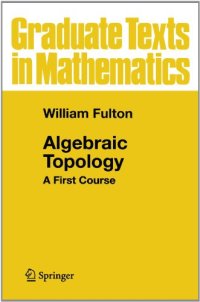
Ebook: Algebraic Topology: A First Course
Author: William Fulton (auth.)
- Tags: Mathematics general
- Series: Graduate Texts in Mathematics 153
- Year: 1995
- Publisher: Springer-Verlag New York
- Edition: 1
- Language: English
- djvu
To the Teacher. This book is designed to introduce a student to some of the important ideas of algebraic topology by emphasizing the re lations of these ideas with other areas of mathematics. Rather than choosing one point of view of modem topology (homotopy theory, simplicial complexes, singular theory, axiomatic homology, differ ential topology, etc.), we concentrate our attention on concrete prob lems in low dimensions, introducing only as much algebraic machin ery as necessary for the problems we meet. This makes it possible to see a wider variety of important features of the subject than is usual in a beginning text. The book is designed for students of mathematics or science who are not aiming to become practicing algebraic topol ogists-without, we hope, discouraging budding topologists. We also feel that this approach is in better harmony with the historical devel opment of the subject. What would we like a student to know after a first course in to pology (assuming we reject the answer: half of what one would like the student to know after a second course in topology)? Our answers to this have guided the choice of material, which includes: under standing the relation between homology and integration, first on plane domains, later on Riemann surfaces and in higher dimensions; wind ing numbers and degrees of mappings, fixed-point theorems; appli cations such as the Jordan curve theorem, invariance of domain; in dices of vector fields and Euler characteristics; fundamental groups
This book introduces the important ideas of algebraic topology by emphasizing the relation of these ideas with other areas of mathematics. Rather than choosing one point of view of modern topology (homotropy theory, axiomatic homology, or differential topology, say) the author concentrates on concrete problems in spaces with a few dimensions, introducing only as much algebraic machinery as necessary for the problems encountered. This makes it possible to see a wider variety of important features in the subject than is common in introductory texts; it is also in harmony with the historical development of the subject. The book is aimed at students who do not necessarily intend on specializing in algebraic topology.